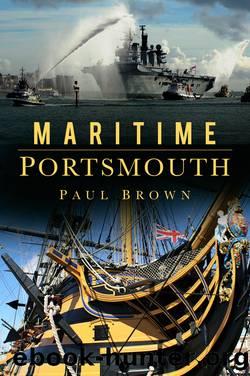Maritime: Portsmouth by Paul Brown

Author:Paul Brown [Brown, Paul]
Language: eng
Format: epub
Publisher: The History Press
Published: 2016-05-16T00:00:00+00:00
The Victory (With the body of Nelson on board) towed into Gibraltar 28th of October, 1805, seven days after the battle of Trafalgar by Clarkson Stansfield, c. 1852. The heavily damaged and jury-rigged HMS Victory is being towed into Gibraltar by HMS Neptune. (Wikimedia Commons)
After Trafalgar
Victory arrived home at Portsmouth on 4 December 1805 under jury rig, with Nelson’s body. After urgent repairs she sailed to the Thames, arriving at Sheerness on 22 December. There the body was transferred to a yacht for passage to Greenwich. Victory paid off at Chatham the following month for a major refit and repairs, and then entered reserve on the Medway. She was re-commissioned in 1808 and her last seagoing service was in the Baltic, as flagship of Rear Admiral de Saumarez, and off the coasts of Spain. She was involved in a number of skirmishes with the Danes in the Baltic and transported troops to and from the Iberian Peninsula in support of Wellington.
She paid off into reserve at Portsmouth in 1812, and from 1813 to 1816 underwent major repairs and reconstruction. After a further spell in Ordinary she became flagship at Portsmouth of, successively, the Port Admiral in 1825, the Admiral Superintendent of the dockyard in 1837 and the Commander-in-Chief, Home Fleet, in 1847. In 1869 she paid off and was used for accommodation and storage as a tender to the new flagship, the Duke of Wellington. In 1887 her lower masts, which had rotted, were replaced by lighter hollow iron masts removed from the armoured frigate Shah, and thus date from that ship’s construction in 1870. In 1899 the custom of flying Nelson’s ‘England Expects’ signal from her masts on Trafalgar Day (21 October) was started. In 1903 the battleship Neptune, which was leaving harbour under tow bound for the shipbreakers, broke loose from her tugs and collided with the Victory. She so badly damaged her that she began to sink and had to be dry-docked for repairs. Together with the general deterioration over time to the fabric of the ship, this incident raised questions about her future but nothing was resolved before the outbreak of the First World War, and Victory remained afloat in Portsmouth Harbour.
Download
This site does not store any files on its server. We only index and link to content provided by other sites. Please contact the content providers to delete copyright contents if any and email us, we'll remove relevant links or contents immediately.
| Automotive | Engineering |
| Transportation |
Small Unmanned Fixed-wing Aircraft Design by Andrew J. Keane Andras Sobester James P. Scanlan & András Sóbester & James P. Scanlan(32686)
Navigation and Map Reading by K Andrew(4965)
Endurance: Shackleton's Incredible Voyage by Alfred Lansing(4631)
And the Band Played On by Randy Shilts(2083)
Wild Ride by Adam Lashinsky(1901)
Top 10 Prague (EYEWITNESS TOP 10 TRAVEL GUIDES) by DK(1900)
The Box by Marc Levinson(1898)
The Race for Hitler's X-Planes: Britain's 1945 Mission to Capture Secret Luftwaffe Technology by John Christopher(1766)
The One Percenter Encyclopedia by Bill Hayes(1754)
Trans-Siberian Railway by Lonely Planet(1665)
Girls Auto Clinic Glove Box Guide by Patrice Banks(1655)
Looking for a Ship by John McPhee(1608)
Batavia's Graveyard by Mike Dash(1586)
TWA 800 by Jack Cashill(1565)
Fighting Hitler's Jets: The Extraordinary Story of the American Airmen Who Beat the Luftwaffe and Defeated Nazi Germany by Robert F. Dorr(1544)
Good with Words by Patrick Barry(1541)
Troubleshooting and Repair of Diesel Engines by Paul Dempsey(1532)
Ticket to Ride by Tom Chesshyre(1522)
Bligh by Rob Mundle(1520)
